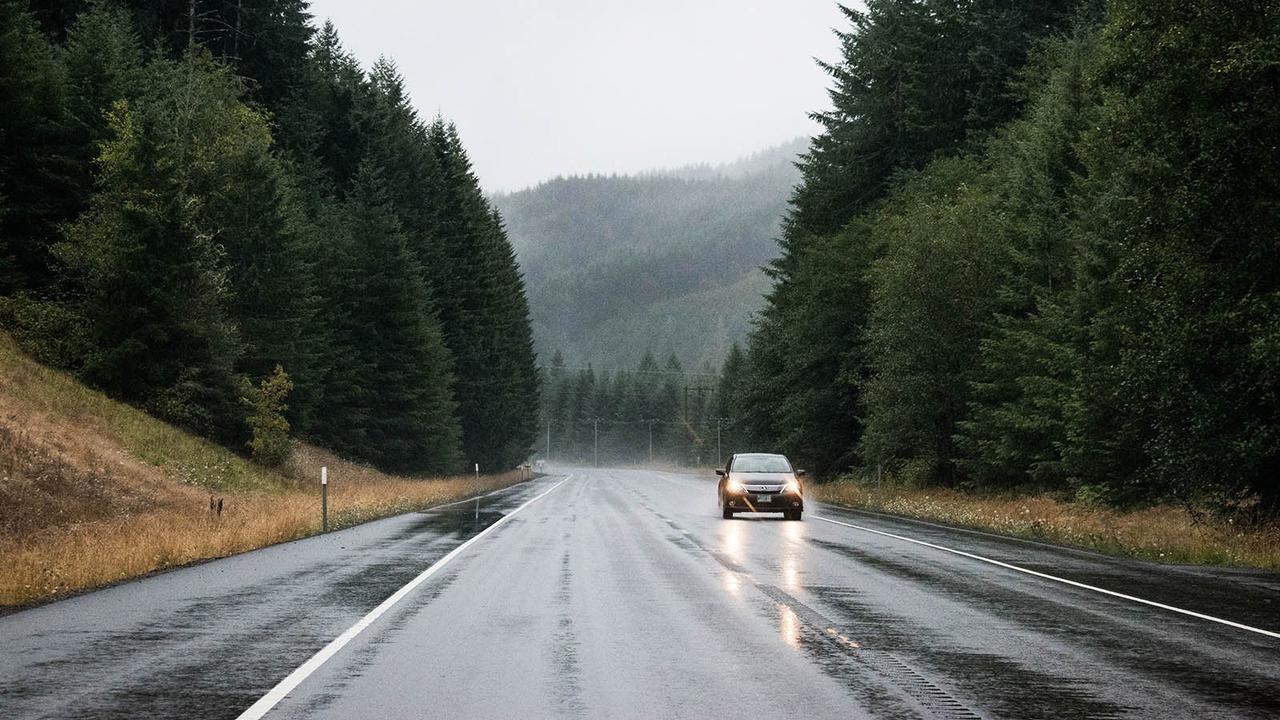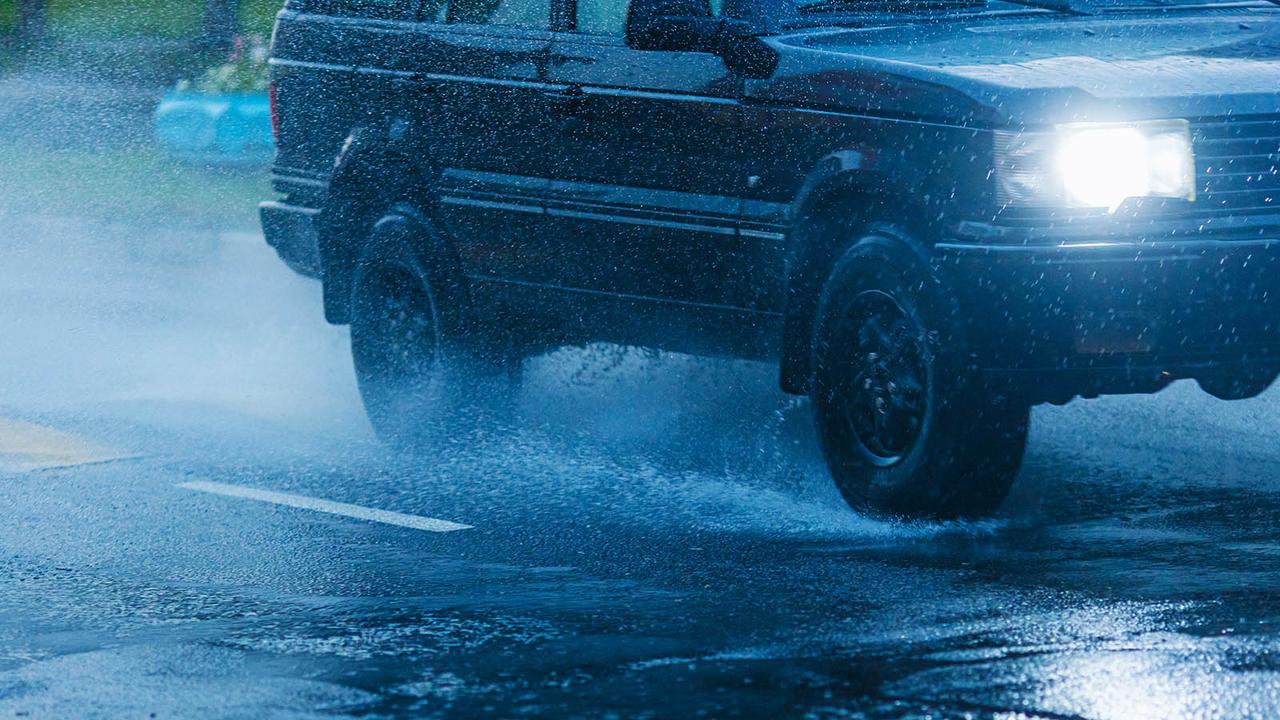Aquaplaning (or hydroplaning) is when a layer of water builds up under your tyres, lifting your car away from the road surface and leading to a loss of control.
What is aquaplaning in a car?
Aquaplaning is one of the biggest dangers when driving in wet conditions. It usually happens at higher speeds, often on motorways or big A-roads. Water builds up under your tyres, causing them to lift up and 'skim' over puddles or streams of water, rather than gripping the road surface underneath.
If your car starts to aquaplane, it's essentially skidding down the road without any grip. This means you have no steering, braking or acceleration control – similar to hitting sheet ice. That puts you at a much greater risk of a crash, as you won't be able to avoid hitting obstacles.
What causes aquaplaning?

Aquaplaning is caused by water on the road surface. This could be puddles, thin layers of flowing water, or standing water from flooding.
Tyre treads are designed with grooves to move water away from the tyre's surface. If there's more water on the road than your tyre can remove, it will lift up away from the road surface, taking your car along with it.
There are three main mistakes drivers make that aquaplaning:
- Driving too fast – this is the most common cause of aquaplaning and is the one that's easiest to avoid. Going too fast in wet conditions means asking your tyres to deal with more surface water than they're able to, leading to your car aquaplaning.
- Not paying enough attention to conditions – you need to take extra care in wet conditions, which includes looking out for potential aquaplaning spots. Motorway puddles are classic aquaplaning culprits and they can be hard to spot if the surface is already wet from the rain. Keep an eye on the road surface ahead of you when the heavens open, and slow down if you see cars ahead splashing through huge puddles.
- Poor tyre condition – your tyre tread wears away over time as you use your car. That means the grooves that move water away get smaller and can't handle as much water as a result, increasing the risk of aquaplaning. This is why you need to replace your tyres when there's little tread depth left, so they'll perform properly in the wet.
How can you tell if your car is aquaplaning?

Modern cars usually insulate you from the sensation of driving down the road, which means it can be tricky to know when your car is aquaplaning.
Here are the signs that your car is aquaplaning:
- Your steering wheel feels unusually light to turn
- You feel the front or rear of the car start to drift slightly
- Your engine noise and revs increase as your driving wheels lose grip
- You feel the car physically slow down as the drag from the water hits the tyres
- You hear a whooshing sound from the tyres as you hit the water
How to avoid aquaplaning

The most important trick to avoiding aquaplaning is to slow down to an appropriate speed for the conditions. This could mean driving a lot slower than the posted speed limit if there's simply too much water on the road for your tyres to cope. Aquaplaning is especially likely on the motorway where traffic moves fast. Stay calm and don't try to match the speed of other cars if you think it isn't safe.
You should also take extra care to watch the road ahead of you in wet conditions. Spotting a large puddle in advance gives you more time to react and to adjust your driving if needed. You should leave even more space between you and other motorists, too, so you have more room to avoid any dangers caused by aquaplaning.
For many safety reasons beyond just aquaplaning, you should keep on top of your vehicle's maintenance. That means servicing in line with scheduled intervals and making any repairs needed to keep it working properly. That's especially true for tyres, which must have at least 1.6mm of tread depth across the middle three quarters of the tyres surface. If they don't, you run the risk of a fine, three penalty points, or even an accident.
What should I do if my car starts aquaplaning?

If your car starts aquaplaning, stay calm and be very gentle with your steering wheel and pedals to bring it back under control. First, hold your wheel straight and gently take your foot off the accelerator – if you have the cruise control turned on, make sure to turn it off. Avoid braking while your car is actually aquaplaning, as this can lead to a skid as the wheels suddenly regain traction.
After easing off the accelerator, your car will slow to a point where the wheels grip the road again. When this happens, you can then gently begin easing onto the brake pedal to slow yourself to a safe speed. Again, be sure to avoid stamping on the pedal harshly as this will upset your car's balance and might lead to a loss of control.
Tyre safety tips to avoid aquaplaning

As we've mentioned, it's crucial your tyres are in good condition when rainy weather hits (all year round in the UK, then…). The law says your tyres must have at least 1.6mm of tread across the width of the tyre, but that's the bare minimum, and we'd recommend replacing your tyres before then.
As well as making sure you have a decent amount of tread, check your tyres are inflated correctly. You'll find your car's recommended tyre pressures on the information label either inside the driver's door opening, or on the inside of your petrol flap. If you don't have a pump at home, use the air pump at your local petrol station to get back up to the right pressure.
Once that's done, make sure your tyres are wearing evenly. Uneven wear could be a sign of poor wheel alignment, which you can have fixed at your local garage. This is also a good time to check your tyres for bulges, punctures and any missing cuts to the sidewall – most of which will require a new tyre.
More top tips to keep you safe on the road
We have a selection of guides to help you stay safe on the roads. Take a look at our explainer for how to drive in heavy rain or learn more about driving safely in the snow. If you're a motorway regular, you might want to check out our guide to driving in high winds.



































